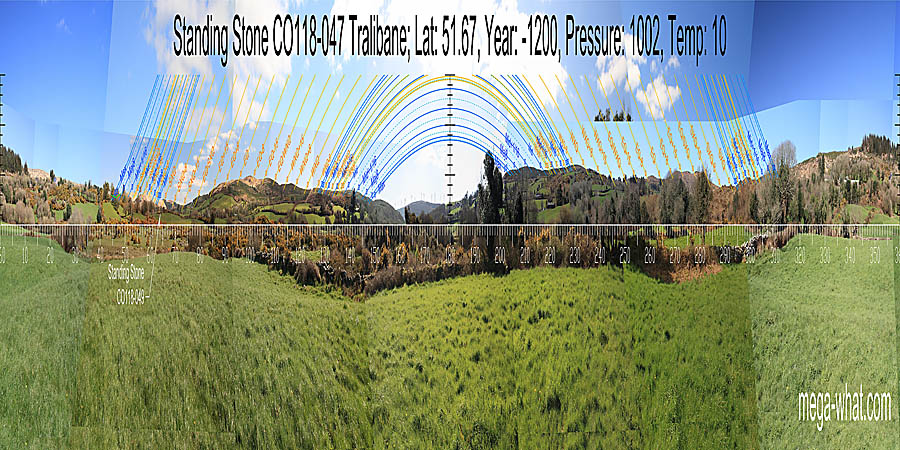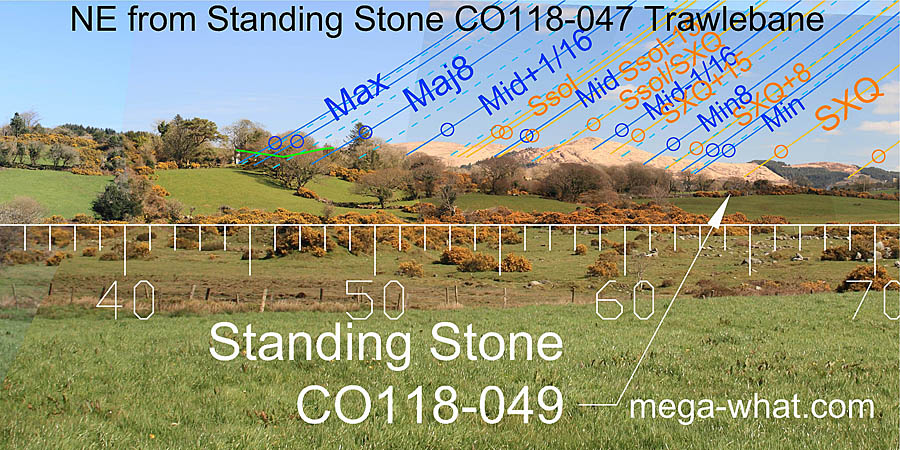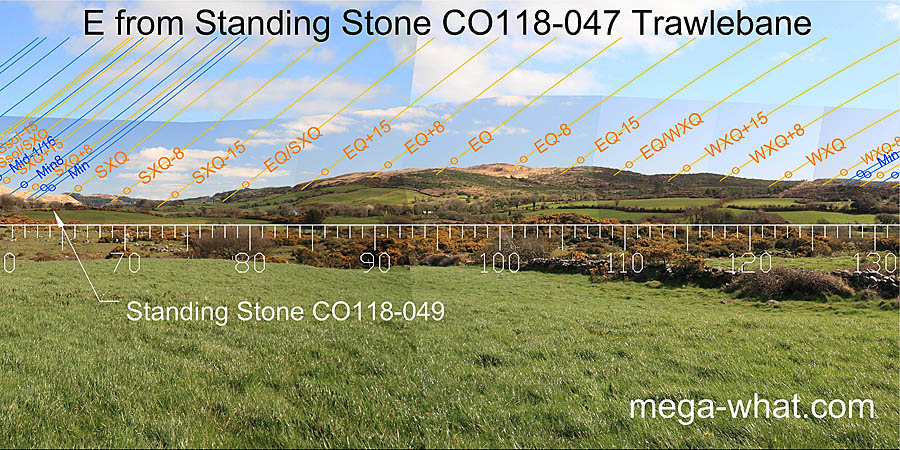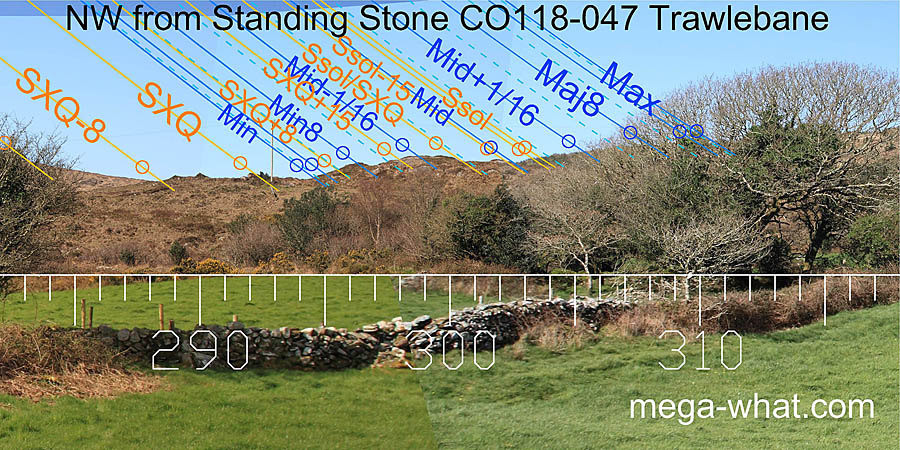 South is marked by the end of a ridge on the right side of a dip [Pic].
South is marked by the end of a ridge on the right side of a dip [Pic].
North is on the right side of a hilltop but detail is obscured [Pic].
 In the north-east, summer solstice, summer cross-quarters and the day half-way between them are marked by tops.
Major and minor standstillsLunistice positions vary cyclically over an 18.6 year period but are fairly static for more than a year at either end of the range
plus the midpoint of the lunisticeLunistices are the most northerly and southerly moons of the month. The lunar equivalent of solstices - more.
cycle are all in dips.
In the north-east, summer solstice, summer cross-quarters and the day half-way between them are marked by tops.
Major and minor standstillsLunistice positions vary cyclically over an 18.6 year period but are fairly static for more than a year at either end of the range
plus the midpoint of the lunisticeLunistices are the most northerly and southerly moons of the month. The lunar equivalent of solstices - more.
cycle are all in dips.
The stone's axis is beyond the major standstillLunistice positions vary cyclically over an 18.6 year period but are fairly static for more than a year at either end of the range in this direction [Pic].
 Eastwards is a hill but its top is not a marker from here. Nonetheless its profile is quite useful.
Winter cross-quarters are at the hill's southern foot while the northern basal dip is a half-month from the summer cross-quarters.
Eastwards is a hill but its top is not a marker from here. Nonetheless its profile is quite useful.
Winter cross-quarters are at the hill's southern foot while the northern basal dip is a half-month from the summer cross-quarters.
 The south-eastern lunisticeLunistices are the most northerly and southerly moons of the month. The lunar equivalent of solstices - more.
range has been nicely fitted to the end of the ridge with the winter solstice sun rising from the central dip of the sequence.
The south-eastern lunisticeLunistices are the most northerly and southerly moons of the month. The lunar equivalent of solstices - more.
range has been nicely fitted to the end of the ridge with the winter solstice sun rising from the central dip of the sequence.
The side view of the stone could be said to indicate the minor standstillsLunistice positions vary cyclically over an 18.6 year period but are fairly static for more than a year at either end of the range and the period between the winter cross-quarters and half-way to the equinox [Pic].
 The south-western lunisticeLunistices are the most northerly and southerly moons of the month. The lunar equivalent of solstices - more.
range runs over double hilltops with the midpoint of the lunisticeLunistices are the most northerly and southerly moons of the month. The lunar equivalent of solstices - more.
cycle in the central dip and the winter solstice in another one.
The south-western lunisticeLunistices are the most northerly and southerly moons of the month. The lunar equivalent of solstices - more.
range runs over double hilltops with the midpoint of the lunisticeLunistices are the most northerly and southerly moons of the month. The lunar equivalent of solstices - more.
cycle in the central dip and the winter solstice in another one.
The stone's axis indicates the centre of the lunisticeLunistices are the most northerly and southerly moons of the month. The lunar equivalent of solstices - more. cycle [Pic].
 To the west, the equinox is in a dip and the half-months to either side are both well marked, as are the equinox / cross-quarter midpoints.
Summer cross quarters are on a low top but winter ones are on a slope.
To the west, the equinox is in a dip and the half-months to either side are both well marked, as are the equinox / cross-quarter midpoints.
Summer cross quarters are on a low top but winter ones are on a slope.
 The north-western horizon is the closest. Minor standstillsLunistice positions vary cyclically over an 18.6 year period but are fairly static for more than a year at either end of the range
and the summer solstice are at the bottom of slopes but the major half of the lunisticeLunistices are the most northerly and southerly moons of the month. The lunar equivalent of solstices - more.
range is obscured.
The north-western horizon is the closest. Minor standstillsLunistice positions vary cyclically over an 18.6 year period but are fairly static for more than a year at either end of the range
and the summer solstice are at the bottom of slopes but the major half of the lunisticeLunistices are the most northerly and southerly moons of the month. The lunar equivalent of solstices - more.
range is obscured.
The side view of the stone could be said to indicate the solstice and the major half of the lunisticeLunistices are the most northerly and southerly moons of the month. The lunar equivalent of solstices - more. range [Pic].
- Trawlebane (Tralibane) Standing Stone CO118-094 is c.500m west-north-west (292°)
- Trawlebane (Tralibane) Standing Stone CO118-049 is c.540m north-east (64°)
- Trawlebane (Tralibane) Five Stone Circle is c.690m north-east (56°)
References
- Archaeological Survey of Ireland, record details. www.archaeology.ie/archaeological-survey-ireland
- POWER, D. et al. 1992 Archaeological Inventory of County Cork, Volume 1: West Cork. Dublin: Stationary Office. p66, no 491.
